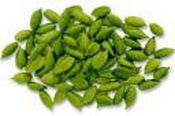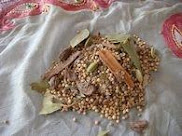A quick fix for Samosa lovers
Traditional Lemon Pickle
Notes from diary 25 August 2009. It's been cold with some morning frosts but the weather is just starting to improve. The locals tell me that it's been a mild winter in Orange this year. I thought it had been a very cold one. I've clearly become too accustomed to the sub-tropical Sydney climate, and I've still got the cold winters of Orange to look forward to, brrr!. Well it serves me right I suppose, I've been boasting to all my Sydney friends and acquaintances about what a lovely climate we have here and yes, it does have it's plusses. The lovely warming log fires, the deeply satisfying comfort food and the beautiful winter produce. Firm and tasty brussels sprouts, deliciously white and sweet cauliflowers, fresh and juicy unwaxed limes and lemons. These are the things I've been buying from Totally Local and the monthly farmers markets as well as silky smooth fresh sheeps milk cheeses, aromatic locally produced olive oils, the tastiest potatoes ever and lots more that I don't have growing yet. The cooking apples (a Russian variety I think) have been wonderful. This is the first time I've been able to buy real cooking apples here in Australia and we've been enjoying the best crumbles and fruit pies I've had in a long time.
Quince Paste and Jam
The quince is an unfortunate looking fruit, a bit like an ugly, oversized pear with an overcoat of some of the apples least favourable characteristics. Raw it is colourless, odourless and tasteless and furiously difficult to prepare. However, cooked with some sugar it becomes enticingly rosy, impossibly fragrant and deliciously fruity and sweet - a transformation nothing short of miraculous.
Foolishly I decided to buy some at the farmers markets. I made some quince paste with half and jam with the rest - quince jam is easier to make than the paste. The jam combined with the apples made a heavenly crumble and the paste was so delicious eaten with the local cheeses, it lasted less than a week. A good excuse to go to lunch at Sisters Rock at Borrie's beautiful orchard and vineyard and buy a whole lot more to make a big batch. I started on them after breakfast the next day. I spent the entire day peeling and chopping the rock hard fruit (after battling with the first one or two I microwaved them to make peeling and chopping easier) and boiling and pureeing and boiling the living day lights out of the resulting puree, while it bubbled and popped all over the walls and ceiling and eventually turned a rich dark brown. Phew! I fell into bed exhausted and determined not to repeat the exercise ever again. To make matters worse, when I went to slice it the following day, it hadn't set. Or least the stuff in the dishes hadn't, the numerous blobs on the walls and ceiling did! I gave it another day, in hope, but had to pour the whole lot back into the pan and boil, splash and pop it some more. I ended up with about a week's cleaning and a year's supply of delicious quince paste if I don't let the kids steal too much of it.
If anyone's daft enough like to me to want to make quince paste and you would like the recipe, e-mail me and I will send it to you.
My winter veggie garden has been doing really well. Winter vegetables really do need cold weather and they are just thriving in this climate. In fact most winter veggies actually improve in flavour after being exposed to frosts and I can vouch for that - we've been enjoying the sweetest, tastiest broccoli, parsnips, baby cauliflowers and spinach that I've ever eaten.. The Chinese Broccoli (Gai Lan) has been particularly tender and tasty as have the snow peas. There have been no problems with pests or deseases and I've hardly had to water them. After the challenges of the summer season this has been so incredibly easy.
Chinese Broccoli
The broad beans looking healthy and robust
Beetroot Bulls Blood - deep red leaves and roots, both of which can be eaten
Well, now for these Cheats Samosas. For someone who makes quince paste why would I think of cheating on making samosas? Anyone who's made samosas 'from scratch' will tell you it is a labour intensive process. Not quite as bad as making quince paste but never-the-less, it is time consuming. In these time poor days most people buy ready made samosas, but they are not a patch in terms of flavour and freshness as home-made. These Cheats Samosas are quick and absolutely delicious.
The secret is to make your own tasty filling and use shop bought tortillas for the pastry casing. It works well.
Cheats Samosas
I love the carrots in this recipe for added flavour and texture, but you can omit them and make up the quantity with more potato.
Makes 12 Samosas
50g (2 oz) diced carrot
150g (5oz) diced potato
2 tbs olive oil
1 onion, finely sliced
2cm piece of ginger, grated or finely chopped
1 or 2 green chillies, finely chopped
½ tsp turmeric
½ tsp of cumin seeds
salt to taste
3 tbsp frozen peas
1 tsp of ambchoor or juice or half a lemon
½ tsp garam masala
6 flour tortillas
Oil for deep frying
- Boil carrot in salted water for 5 minutes and add the potato. Cook until vegetables are tender but not breaking apart. Drain.
- Meanwhile, heat the oil in a heavy based sauce pan and add the onion. Fry for a few minutes over medium heat until beginning to colour around the edges.
- Add the ginger, chillies, turmeric, cumin and salt and stir fry for 2 minutes. Stir in the cooked vegetables, peas, ambchoor and garam masala. Mix well over low heat for a few minutes so that the vegetables absorb the spices.
- Turn off the heat and allow the filling to cool.
- Dampen a tortilla by dipping briefly in warm water. Slice in half and bring the cut sides together, slightly overlapping, to make a hollow cone. Seal by pressing the cut sides together firmly. You may need to dampen the edges with a little more water.
- Fill about ¾ full with the potato mixture, being careful not to overfill. Pinch the open ends together firmly to enclose the filling. Set aside and repeat with remaining tortillas.
- Deep fry in batches and drain on a wire rack. Serve hot with Tamarind Sauce or tomato ketchup.
2 tsp of tamarind paste
200 ml (7fl.oz) warm water
½ tsp salt
½ chilli powder
½ tsp garam masala
½ tsp ambchoor
1tbsp tomato ketchup
1 carrot, grated
1 tbsp diced red onion
1 tbsp of chopped coriander
Dissolve the tamarind paste in the water. Add the remaining ingredients and mix to combine.
Traditional Lemon Pickle
There are lots of different recipes for lemon and lime pickle, with and without oil. Home-made pickles are intensely flavoursome, much more so than most commercial brands, and it is worth making some. This recipe is really simple and allows the fresh flavour of the lemons or limes and other ingredients to really shine through. It is great with all sorts of food and you can even use the pickled lemon for recipes that call for preserved lemons.
Vary the quantities of ginger, chillies and garlic according to preference.
500g (1lb 3oz) lemons or yellow limes
12 red chillies
100g (3oz) ginger
1 bulb garlic
2 tsp turmeric
3 tbsp salt
1 tsp chilli powder
100ml (3 fl. oz) white vinegar or lemon juice
- Rinse the lemons and chillies and wipe dry. Peel the ginger and slice thickly. Divide the garlic bulb in to cloves and peel.
- Spread the ingredients out on the bench top or large tray and air dry over night or for at least 1 hour.
- Meanwhile, rinse a large glass or ceramic jar and lid (needs to be a tight fitting one) in hot soapy water. Rinse in very hot water and dry thoroughly.
- Combine turmeric, salt and chilli powder in a small bowl.
- Quarter the lemons and place about a third of them in the jar. Add about a third of the garlic, ginger slices and chillies and sprinkle over about a third of the turmeric mixture. Pour over about a third of the lemon juice or vinegar.
- Repeat twice more with remaining ingredients.
- Shake the jar well and place in bright light (preferable sunlight) on a window ledge or outdoors during the day if weather permits.
- Shake the jar at least twice daily to mix the ingredients for 7-14 days. In hot sunny weather this pickle will be ready to eat in 7 or 8 days.
- Store the pickle in a cool place.

















1 comments:
These sound delicious. Will have to give them a go soon. I usually buy filo pastry to make samosas and in spain we can easily buy a quince paste called "membrillo". Yum,I'm salivating already.
Post a Comment